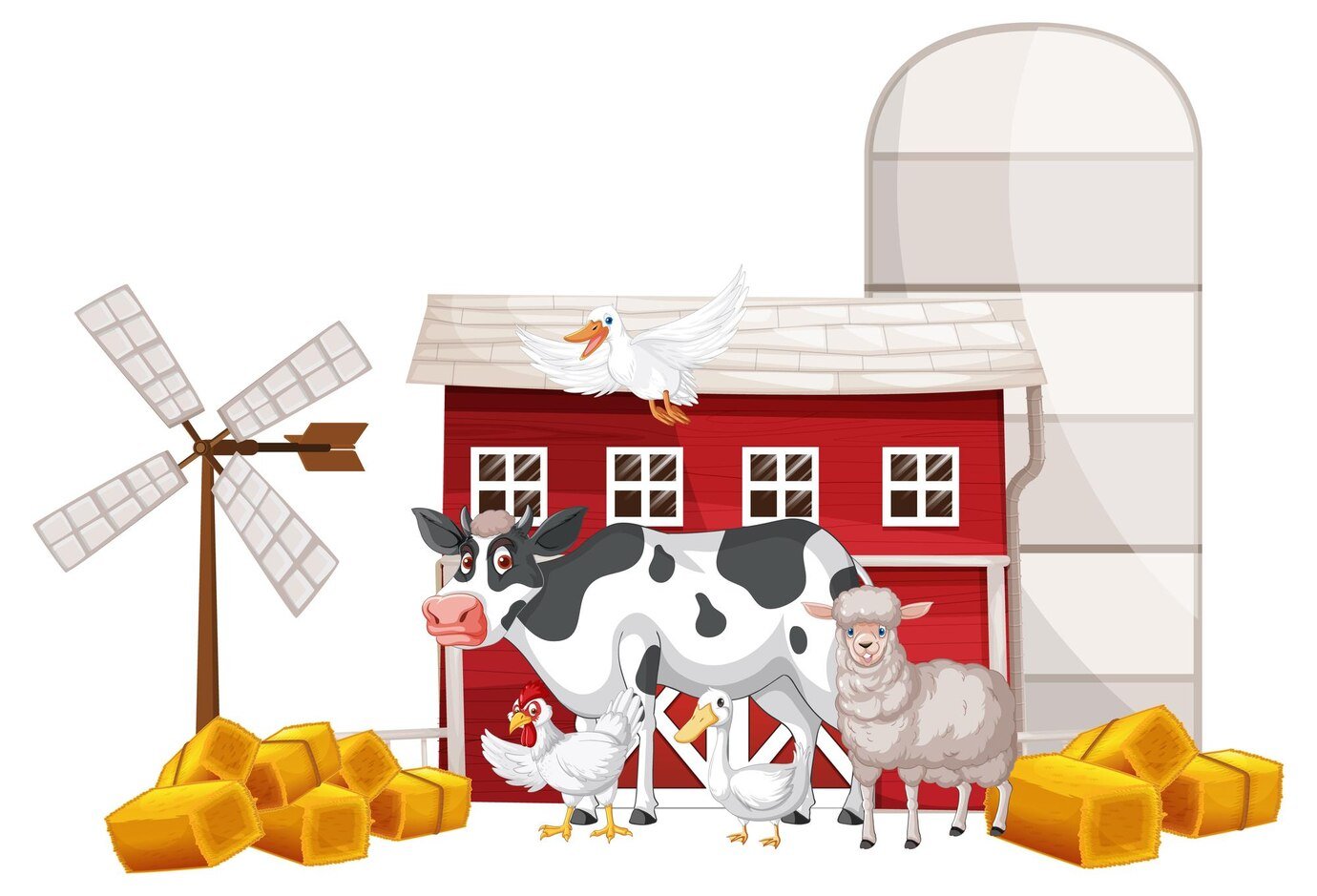Creating a financial model for a dairy farm is essential for both experienced operators and new farmers. A clear model evaluates the farm’s viability, forecasts cash flow, and supports smart investment and operational decisions. It also helps manage risks effectively. In this guide, we’ll show you how to build a complete dairy farm financial model, focusing on key metrics and critical factors at every step.
We have also built a Dairy Farm Financial Model Template for Founders and Entrepreneurs to use. Simply enter your assumptions into our model, and it will do the rest! This complete 3-way financial model includes an Income Statement, Balance Sheet, and Cash Flow Statement, along with dairy-specific metrics, ratios, and a valuation page to determine your farm’s worth.
What is a Dairy Farm Financial Model?
A dairy farm financial model provides a structured view of the farm’s financial performance over three to five years. It projects revenue, expenses, capital costs, and key performance indicators (KPIs) to assess the farm’s efficiency and profitability.
Key Components of a Dairy Farm Financial Model

- Revenue Projections: Estimations of income from milk sales, livestock sales, and other sources.
- Operating Expenses: Direct and indirect costs associated with running the dairy farm.
- Capital Expenditures: Investments in infrastructure, equipment, and livestock.
- Financing Costs: Interest and principal payments on any loans taken to finance the farm.
- Cash Flow Analysis: Assessment of cash inflows and outflows over time.
- Key Performance Indicators (KPIs): Metrics that help assess the financial health of the farm.
Important Metrics to Include

- Milk Production per Cow: Average milk yield per cow, usually measured in liters or gallons.
- Herd Size: The total number of cows on the farm.
- Milk Price: The price per liter or gallon of milk sold.
- Feed Costs: The cost of feed per cow, which can fluctuate based on market conditions.
- Operating Expense Ratio (OER): A ratio that measures operating expenses as a percentage of total revenue.
- Debt Service Coverage Ratio (DSCR): A measure of cash flow available to cover debt obligations.
- Net Profit Margin: The percentage of revenue that represents profit after all expenses.
How to Build a Dairy Farm Financial Model?
Step 1: Define Your Assumptions
Start by outlining the key assumptions that will drive your financial model. These should include:
- Herd Size: The number of cows you plan to keep.
- Milk Production per Cow: Average yield in liters or gallons.
- Milk Price: Expected selling price per liter or gallon.
- Feed Costs: Average cost per cow for feed.
- Labor Costs: Expected costs for farm labor.
- Other Operating Expenses: Include veterinary care, maintenance, utilities, insurance, and miscellaneous costs.
Example Assumptions
- Herd Size: 100 cows
- Milk Production per Cow: 25 liters per day
- Milk Price: $0.50 per liter
- Feed Costs: $3 per cow per day
- Labor Costs: $4,000 per month
- Other Operating Expenses: $2,000 per month
Step 2: Structure Your Model
Organize your financial model in a spreadsheet for clarity and ease of use. Common sections to include are:
- Input Assumptions: A dedicated section for all key metrics.
- Revenue Projections: Detailed forecasts of milk sales and other income.
- Operating Expenses: Breakdown of all operating costs.
- Capital Expenditures: Plans for any major investments.
- Cash Flow Statement: Summary of cash inflows and outflows.
- Key Performance Metrics: Summary of important financial ratios and metrics.
Step 3: Create the Input Assumptions Sheet for Dairy Farm Financial Model
Set up an input assumptions sheet in your spreadsheet where all key metrics are clearly defined. This sheet will serve as the foundation of your model, making it easy to update and adjust assumptions without affecting the overall structure.
Step 4: Calculate Revenue Projections
To forecast your revenue, focus primarily on milk sales:
- Daily Milk Production:
Daily Milk Production = Herd Size × Milk Production per Cow
- Annual Milk Production:
Annual Milk Production = Daily Milk Production ×365
- Total Revenue from Milk Sales:
Total Revenue = Annual Milk Production × Milk Price
Example Calculation
Assuming a herd size of 100 cows producing 25 liters of milk each:
- Daily Milk Production:
100 ×25 = 2,500 liters
- Annual Milk Production:
2,500 × 365 = 912,500 liters
- Total Revenue from Milk Sales at $0.50 per liter:
912,500 × 0.50 = $456,250
Step 5: Estimate Operating Expenses
Next, calculate your operating expenses, which can include feed costs, labor, and other costs:
- Annual Feed Costs:
Annual Feed Costs = Feed Costs per Cow per Day × Herd Size ×365
- Annual Labor Costs:
Annual Labor Costs = Labor Costs per Month ×12
- Total Operating Expenses:
Total Operating Expenses = Annual Feed Costs + Annual Labor Costs + Other Annual Operating Expenses
Example Calculation
Assuming feed costs of $3 per cow per day, labor costs of $4,000 per month, and other operating expenses of $2,000 per month:
- Annual Feed Costs:
3 × 100 × 365 = $109,5003
- Annual Labor Costs:
4,000 × 12 = $48,000
- Total Operating Expenses (assuming $2,000/month for other costs):
Other Annual Operating Expenses = 2,000 × 12 = 24,000
- Total Operating Expenses:
109,500 + 48,000 + 24,000 = $181,500
Step 6: Calculate Net Profit
Now, calculate the net profit by subtracting total operating expenses from total revenue:
Net Profit = Total Revenue − Total Operating Expenses
Example Calculation
Net Profit = 456,250 − 181,500 = $274,750
Step 7: Calculate Key Performance Indicators (KPIs)
KPIs help you assess the financial health and operational efficiency of the dairy farm. Key KPIs include:
- Operating Expense Ratio (OER):
OER = Total Operating Expenses / Total Revenue
- Net Profit Margin:
Net Profit Margin = Net Profit / Total Revenue × 100
- Debt Service Coverage Ratio (DSCR): If applicable, calculate this to assess the ability to cover debt obligations:
DSCR = Net Operating Income / Total Debt Service
Example Calculation
- Operating Expense Ratio (OER):
OER = 181,500 / 456,250 ≈ 0.397 or 39.7%
- Net Profit Margin:
Net Profit Margin = 274,750 / 456,250 × 100 ≈ 60.2%
Step 8: Cash Flow Analysis
A cash flow statement summarizes all cash inflows and outflows over a specific period, usually annually. It helps you understand the liquidity of the dairy farm.
- Cash Inflows: Include all revenues from milk sales and any other sources.
- Cash Outflows: Include all operating expenses and any capital expenditures.
Example Cash Flow Summary
| Year | Cash Inflows | Cash Outflows | Net Cash Flow |
|---|---|---|---|
| 1 | $456,250 | $181,500 | $274,750 |
| 2 | $467,500 | $185,000 | $282,500 |
| 3 | $480,000 | $190,000 | $290,000 |
Step 9: Capital Expenditures
If you plan to invest in capital expenditures (capex) such as new machinery, infrastructure, or additional livestock, include these in your model.
- Capex: List the expected capital expenditures and how they will be financed (e.g., loans, equity).
- Depreciation: Account for depreciation of fixed assets, which impacts taxable income.
Example Capex Calculation
Assuming a one-time capital expenditure of $50,000 for new equipment:
- Annual Depreciation (assuming a useful life of 10 years):
Annual Depreciation = 50,000 / 10 =$5,000
Step 10: Perform Sensitivity Analysis
Conduct sensitivity analysis to understand how changes in key assumptions affect your financial projections. Test various scenarios, such as:
- A higher or lower milk price.
- Changes in feed costs.
- Variations in milk production per cow.
Step 11: Review and Refine Your Model
Once your initial model is complete, review it for accuracy and logical flow. Ensure that all calculations are correct and that inputs are clearly defined. Seek feedback from industry peers or financial advisors to identify areas for improvement.
Step 12: Use the Model for Decision-Making
Now that you have a comprehensive financial model, leverage it for decision-making. Whether considering expansion, refinancing options, or changes in feeding strategies, your model can provide valuable insights.
Example Scenarios for Decision-Making
- Expansion Analysis: Evaluate the financial implications of increasing herd size.
- Cost Management: Identify areas for reducing feed costs or labor expenses.
- Market Conditions: Assess how fluctuations in milk prices impact profitability.
Final Thoughts!
Building a financial model for a dairy farm is essential for understanding its potential and sustainability. So, how to build a dairy farm financial model? All you need to define assumptions, structure the model, calculate revenues and expenses, and analyze key metrics to create a reliable tool for decision-making. As you gain experience, refine the model with advanced techniques and real data to improve accuracy. With practice, you’ll confidently navigate dairy farm finances. You can also buy our ready-to-go Dairy Farm Financial Model Template which is perfect for Founders to model out their business!
Here are some excellent articles you may find useful: Enhancing Dairy Farm Efficiency: Business Analysis and Benchmarking, 5 dairy farm metrics to monitor and Key performance measures of farm profitability.



